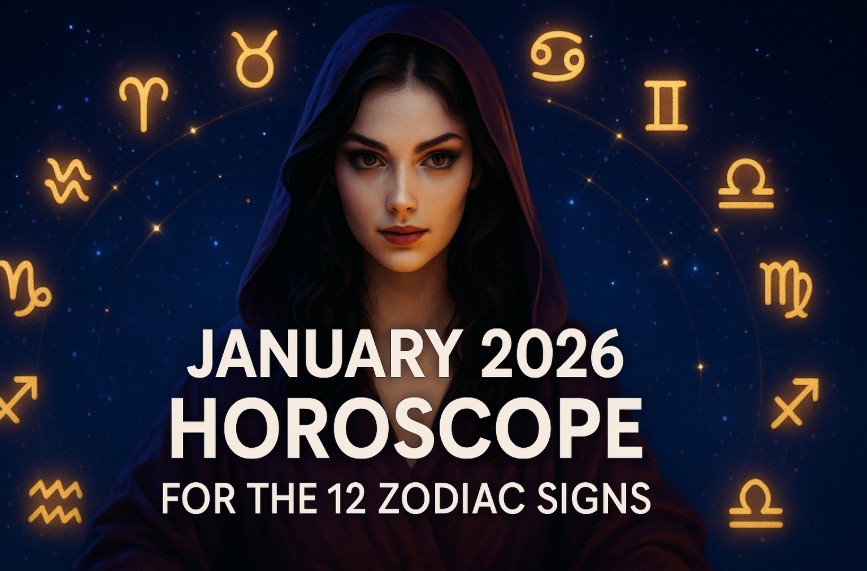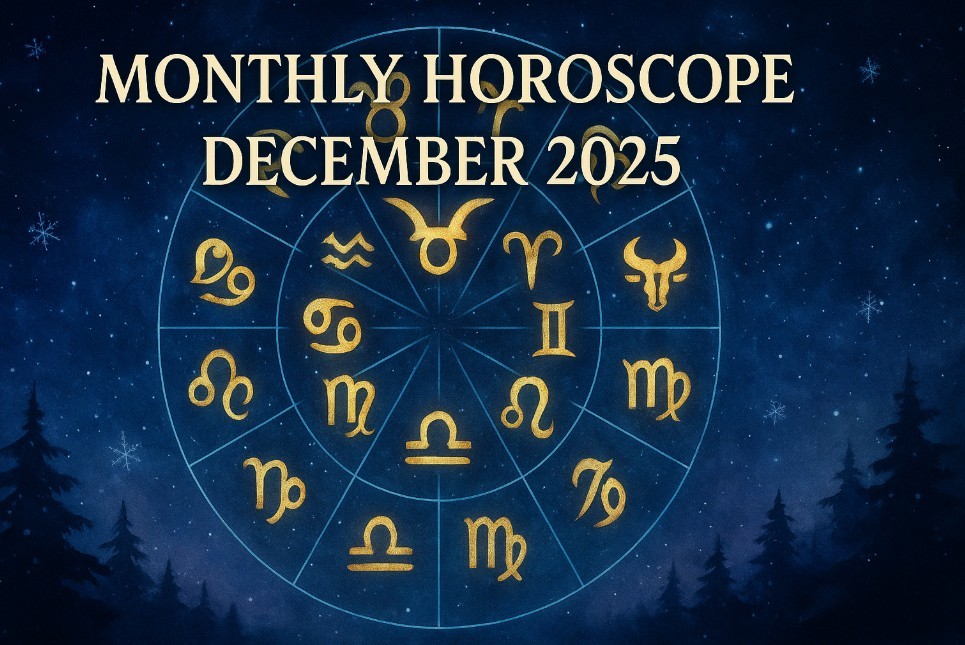How To Find The Position of 12 Zodiac Signs By SmarthPhone
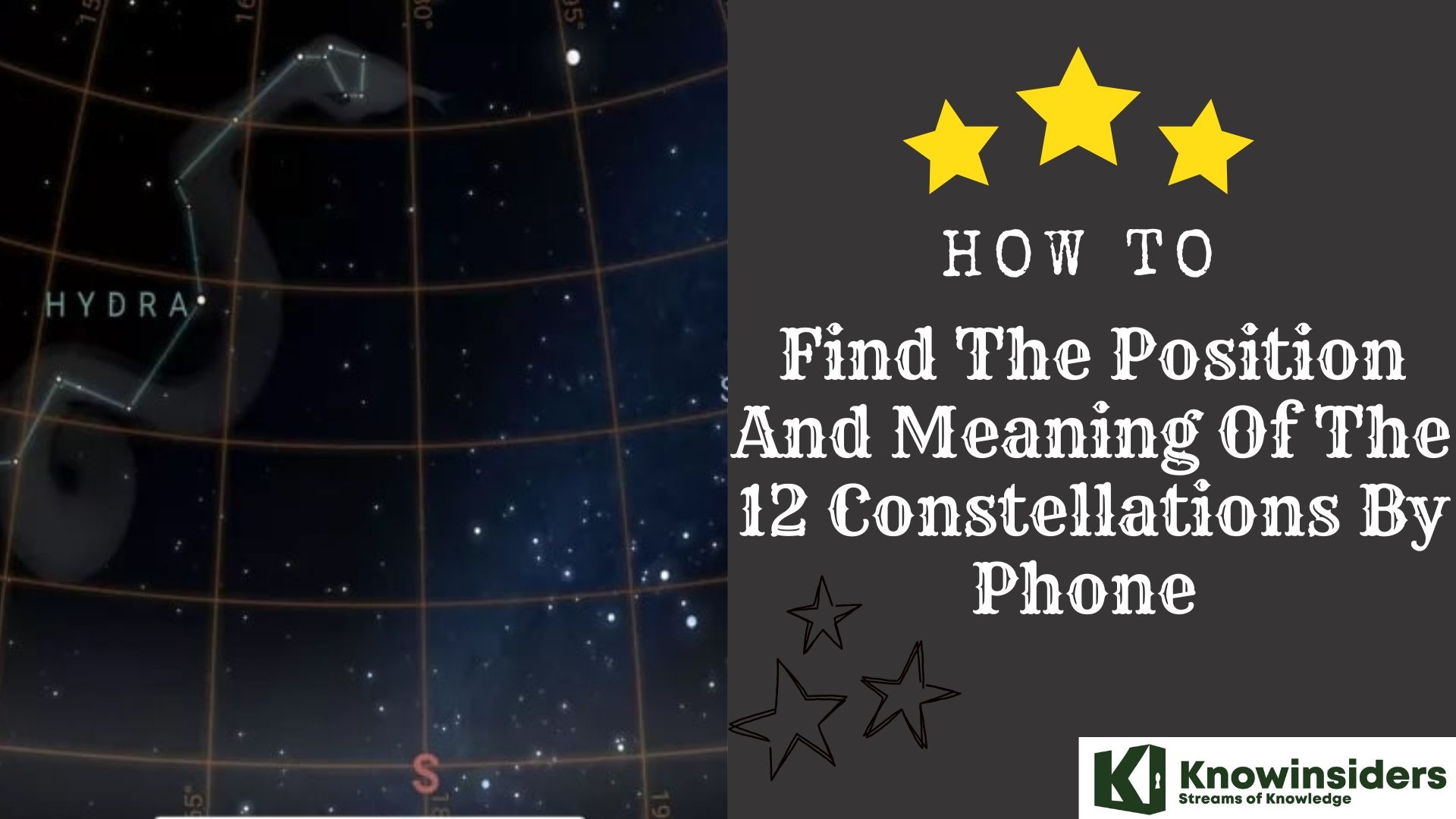 |
| How To Find The Position And Meaning Of The 12 Constellations By Phone Knowinsiders.com |
| Table of Content |
A star-studded night sky is a beautiful sight to behold. You might think a glowing rectangle would ruin the experience—and it can—but it can also enhance it. Finding constellations is easy with the right app.
When smartphones first entered the mainstream, apps like Google Sky Map They showed their potential. However, these apps weren’t just a gimmick to show the accelerometer. There are still great apps out there that let you find constellations simply by pointing your phone at the sky.
Here are how you can find the position and meaning of the 12 constellations by your smart phone.
What are the 12 Constellations of the Zodiac?
A constellation is a cluster of stars in the sky that are grouped together in a particular pattern and which have been given a name. The most famous constellations come mainly from the classical Greek tradition, such as Cassiopeia, Hercules, Pegasus or Ursa Major. However, none of these constellations are part of the zodiac.
The constellations found in the zodiac will surely ring a bell. Gemini, Leo, Sagittarius or Scorpio are familiar names to most of us. When grouped with the other Zodiac constellations, which add up to twelve, they form a pattern in the sky. This pattern has been used for ages by astronomers, as it makes it easier for observers to track the movement of the solar system and the stars throughout the course of the year.
In other words, the zodiac constellations make a two-dimensional map of the sky that is very useful for orientation. It made life easier for ancient astronomers to find objects and explain their location in the sky, as well as for travelers and sailors, who use the stars to determine their position.
The twelve constellations of the zodiac lie along the plane of the ecliptic. The ecliptic is defined by the circular path of the Sun across the sky as seen from Earth. In other words, the Sun appears to pass through these constellations over the course of a year. It is because of this predictable cycle that the journey of the Sun through the zodiac was used by ancient cultures to determine the time of year. In this way, the so-called cardinal constellations of the zodiac (Aries, Cancer, Libra and Capricorn) mark the beginning of the four seasons. The Sun enters these constellations on the first days of spring, summer, autumn and winter respectively.
In fact, the word Zodiac translates to circle of animals, or circle of life, in ancient Greek. This explains why most of its constellations are represented as animals or mythical creatures. The 12 constellations of the zodiac are Aries, Taurus, Gemini, Cancer, Leo, Virgo, Libra, Scorpius, Sagittarius, Capricornus, Aquarius and Pisces. All of these, as well as the full circle of the zodiac are easily visible in present-day star maps among other constellations.
The Sagittarius Constellation
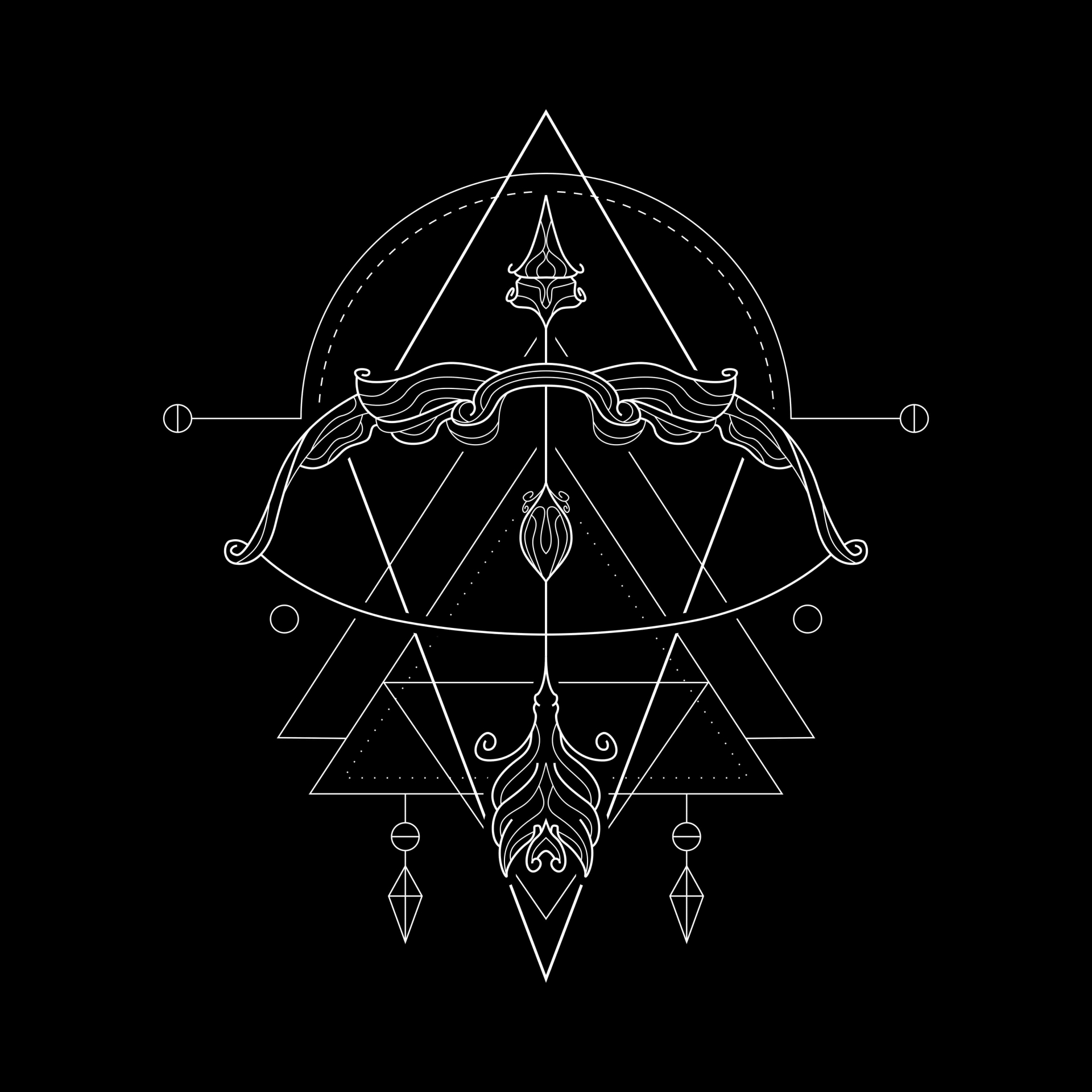 |
| Photo: Underluckystars |
At the end and of every year, approximately between November 23 and December 21, the sun passes through the Sagittarius constellation. The Greeks called Sagittarius The Archer, because it reminded them of the centaur, who was represented by the symbol of a bow and arrow, in their mythology.
The Capricorn Constellation
 |
| Photo: Underluckystars |
The sun transits through the Capricorn constellation in January through February. It’s sometimes called The Sea Goat, since the ancient Greeks compared it to a goat with a fish instead of a tail. It is one of the four cardinal signs and it traditionally marked the winter solstice. The name Capricorn is a direct heritage from the ancient Greeks. As the myth goes, Capricorn was the first hybrid creature created by Hermes, the messenger god.
The Aquarius Constellation
 |
| Photo: Underluckystars |
In February, it’s Aquarius, or the Water Bear, which is on the path of the sun along the ecliptic. This constellation is one of the oldest we know, as it was coined by the ancient Babylonians, who thought it resembled an old man pouring water from a pitcher. This metaphor meant to them that Aquarius was the bringer of rain. It was also a symbol of knowledge and wisdom.
Covering an area of 979.85 square degrees, Aquarius is the second largest zodiac constellation and the tenth largest constellation in our sky.
The Pisces Constellation
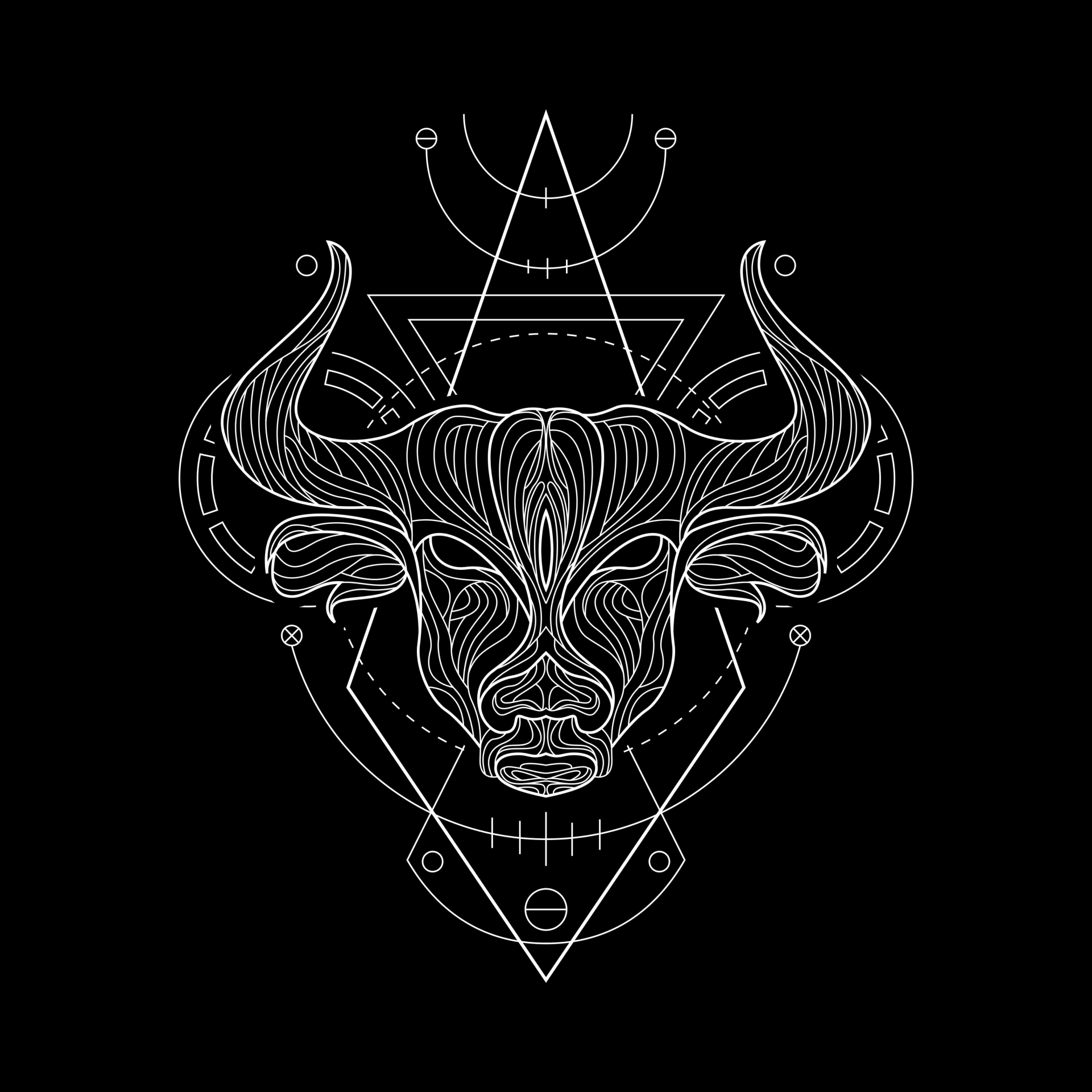 |
| Photo: Underluckystars |
Pisces, or “The Fishes”, becomes prominent in the ecliptic every year in the month of March. The Pisces constellation represents the Greco-Roman goddess Venus, or Aphrodite in its Greek name. The myth says the goddess turned herself into a fish in order to escape from an evil monster.
The Aries Constellation
Aries shows up in the month of April. This constellation of the Zodiac is also known as “The Ram”, and is one of the four cardinal signs. This is yet another heritage from Greek mythology, in which Aries was a legendary ram with wings, and also represented Ares, the god of war. For the ancient Babylonians, however, the Aries constellation represented the Spring equinox and was a symbol of fertility.
The Taurus constellation
The constellation of Taurus reaches its highest point between the months of April and May. Cultures all over the world recognize the Taurus constellation as the shape of a bull. It’s named after the Roman god Jupiter, or Zeus according to the Greek tradition, who would turn himself into a bull to visit the world of the mortals. It also traditionally symbolized the coming of spring and was considered a sign of fertility.
The Gemini Constellation
The constellation most prominent along the ecliptic during the month of June is Gemini, also called “The Twins”. Its shape reminded the ancient Greeks of the twin sons of Zeus. In fact, its brightest stars, Castor and Pollux, represent the Gemini twins. The most popular story of Gemini tells that the twins partook in cattle theft when the Milky Way was made up of a herd of dairy cows.
The Cancer Constellation
The Cancer constellation becomes visible to the naked eye in July. It is also known as “The Crab” because of its multiple legs and extremities. According to the ancient Greek legend, the gigantic crab is one of the many creatures battled by the hero Heracles (also known as Hercules in the Roman tradition).
The Leo Constellation
By the end of the month of July, and during most of August, it is the constellation of Leo which lies along the path of the sun. For ancient observers, it resembled the shape of a lion. A fun fact about this constellations is that ancient Egyptians would recognize the coming of Leo due to the timing of the Nile tide.
The Virgo Constellation
Most prominent in September, the Virgo constellation is called “The Maiden” and is usually depicted as a lady holding grains of wheat. It symbolized the harvest for both the ancient Greek and Roman civilizations. Other associations attributed to Virgo are prosperity, justice and purity.
The Libra Constellation
The sun passes through Libra between September and October, when the days and nights are roughly equal in length. It is considered a symbol of balance. Curiously, it is the only constellation of the Zodiac not represented by a creature, animal or person.
The Scorpio Constellation
Easily to infer from its name, the Scorpio constellation has the shape of a scorpion. The Sun transits this constellation on average from October 23 to November 22. According to the myth, the Scorpio constellation was created by the Greek deity Artemis, the goddess of hunting, wild animals and the wilderness.
What are Zodiac Constellations’s Position?
Taurus and Gemini
The zodiac constellations best seen in the winter are Taurus and Gemini. The constellations’ brightest stars, Aldebaran and Pollux, are part of the Winter Circle, a large hexagon asterism formed by six first-magnitude stars. Both constellations are easily found using the bright stars of Orion.
The celestial Bull is very easy to identify because it contains two exceptionally bright open clusters, the Pleiades and the Hyades. The V-shaped Hyades cluster marks the Bull’s head and the Pleiades, its shoulder. The constellation’s brightest star, Aldebaran (Alpha Tauri), lies in the same line of sight as the Hyades and marks one of the Bull’s eyes. The orange giant Ain (Epsilon Tauri) marks the other. Unlike Aldebaran, Ain is a member of the Hyades. Aldebaran and the Hyades can be found by following the line of Orion’s Belt in the direction of Orion’s Shield. Aldebaran is the brightest star along the imaginary line.
The Bull’s horns can be found using the V of the Bull’s head. The northern horn is marked by the blue giant Elnath (Beta Tauri), a star that appears as part of Auriga’s hexagon. The southern horn is marked by Tianguan (Zeta Tauri), another class B giant. Zeta Tauri is commonly used to find the Crab Nebula (Messier 1), a bright supernova remnant in Taurus. In the opposite direction, the V of the Hyades points toward Lambda Tauri, the star that marks the Bull’s chest.
Cancer, Leo and Virgo
The spring zodiac constellations Leo and Virgo are easily found using the bright stars of the Big Dipper and the constellation Cancer can be identified using the Sickle of Leo, Castor and Pollux in Gemini, and Procyon in Canis Minor.
The brightest parts of Leo and Virgo appear as a backwards question mark and the letter Y respectively. Known as the Sickle of Leo, the question mark outlines the head and mane of the Lion. Regulus, the brightest star in Leo, marks the base of the Sickle and the heart of the Lion and the bright Denebola marks the Lion’s tail. Regulus can be found using Megrez and Phecda, the inner stars of the Big Dipper’s bowl. A line drawn from Megrez through Phecda points towards the Sickle.
Spica, the brightest star in Virgo, is found using the arc of the Big Dipper’s handle. Following the arc leads first to Arcturus, the brightest northern star, and then to Spica. Spica sits at the base of the Y of Virgo, an asterism that appears as the most visible part of Virgo’s constellation figure. Spica marks Virgo’s ear of grain. Porrima and Zavijava mark her left wing, Zaniah the left arm, and Vindemiatrix the right wing.
The best time of year to observe these constellations in the evening is during the months of spring. Cancer is best seen in March, Leo in April, and Virgo in May.
Libra and Scorpius
The southern zodiac constellations Libra and Scorpius are found between the Y of Virgo and the Teapot in Sagittarius. Libra’s brightest stars, Zubeneschamali and Zubenelgenubi (Beta and Alpha Librae) appear as the extended claws of the Scorpion. The constellation itself was seen as part of Scorpius in ancient Greece and given separate status by Claudius Ptolemy, who catalogued it as Chelae (Claws) in his Almagest.
The scales asterism is formed by Zubeneschamali and Zubenelgenubi with Zubenelhakrabi (Gamma Librae), Brachium (Sigma Librae), Tau and Upsilon Librae.
Libra and Scorpius are best seen in the summer. The best month to observe Libra in the evening is June. For Scorpius, it is July.
Sagittarius and Capricornus
Sagittarius is very easy to identify because its eight brightest stars form a prominent asterism known as the Teapot. Visible above the horizon during the northern hemisphere summer, the Teapot is located just next to a rich Milky Way field in the southern sky. Alnasl, the star at the tip of the spout, marks the Archer’s arrowhead and Kaus Borealis, Kaus Media and Kaus Australis outline the bow.
The Teapot is used as a guide for finding numerous bright deep sky objects in this region of the sky. The best-known ones include the Omega Nebula (Messier 17), Trifid Nebula (Messier 20) and Lagoon Nebula (Messier 8) in Sagittarius, and the Eagle Nebula (Messier 16) in Serpens.
The best time of year to see the stars of Sagittarius and Capricornus is during the summer months. Sagittarius is best seen in August and Capricornus in September.
Aries, Pisces and Aquarius
Aries, Pisces and Aquarius can be found using the bright Square of Pegasus, an asterism that dominates the northern evening sky. Alpheratz, the top left star of the Square is the first in a line of three bright stars in Andromeda that lie between Pegasus and Perseus. Aries is found below Mirach, the central of the three stars, and below the constellation figure of Triangulum. Hamal, Sheratan and Mesarthim, the brightest stars in Aries, form a flat triangle just below the elongated triangle of Triangulum.
The triangle that forms the head of the eastern fish in Pisces lies west of the line connecting Hamal in Aries and Mirach in Andromeda. The stars that form it are faint and difficult to make out, but the base of the triangle is roughly parallel to the line connecting the two brighter Aries stars.
The head of the western fish is easier to locate because it is somewhat brighter and lies directly below the Great Square of Pegasus. The asterism that represents the head is known as the Circlet of Pisces. The heads of the eastern and western fishes are connected by cords of relatively faint stars that connect at Alrescha (Alpha Piscium). Alrescha lies near the circle of stars that represents the head of Cetus. Despite the Alpha designation, it is not the brightest star in Pisces. The constellation’s lucida, Alpherg (Eta Piscium), is part of the eastern cord. It shines at magnitude 3.61 and is not very conspicuous in the sky.
The best time to see Aries, Pisces and Aquarius is during the autumn months. Aquarius is best seen in the evenings in October, Pisces in November, and Aries in December.
How to find the position of 12 constellations by your smartphone?
1. Google Sky
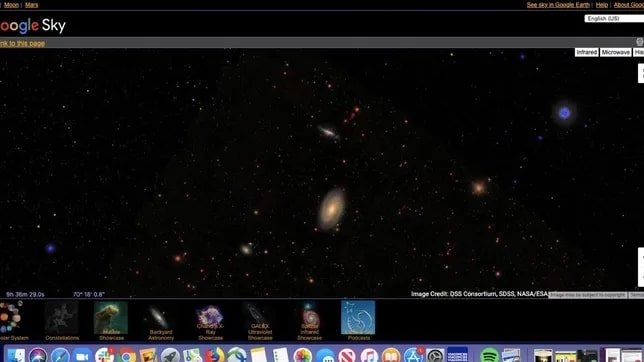 |
| Photo: CNET |
Google Sky is a great way to view the planets, constellations, birth of galaxies, and other items in the universe. It uses some of the best images from the Hubble Telescope and other observatories around the World. Select thumbnail images along the bottom of the screen to quickly access planets, constellations, stars, galaxies, and nebulae. Use layers that are created using different wavelengths such as x-ray, ultraviolet, and infrared light. Type in the name of your favorite planet, star, or constellation in the search field to find it quickly and then zoom in for greater detail and information.
Google Sky is the space version of Google’s Earth application. Simply put, it allows users to view a set of images from space. Rather than browsing across town in Google Earth, students can peruse the “street-view” of the universe, visiting planets and space objects far off in the galaxy. The images displayed are a compilation of pictures from NASA satellites, the Hubble Telescope, and a few other sources. The value of the Google Sky application (available both as a standalone application as a part of the free Google Earth download or as a web-based version at http://www.google.com/sky/) is that all of this information is compiled into one easy-to-use tool. Moving from one galaxy to the next is as easy as dragging your mouse and clicking. Google recently added access to the Slooh Space Camera where students can view live space footage through a telescope via the application. Google Sky would fit within any classroom where students are learning astronomy or studying the Ancient constellations. Integrated into the application are links to other web-based astronomy resources from photos to podcasts. Google Sky is a one-stop shop for all of your astronomical investigations.
Google Sky lets you explore the reaches of space through the "eyes" of the Hubble Space Telescope, the Sloan Digital Sky Survey and the Digitized Sky Survey. You can explore the wealth of information available free on mobile or desktop.
Click through the tray at the bottom of the screen to learn more about the solar system, constellations, galaxies and nebulae, views of the universe in x-ray, ultraviolet and infrared. You can also use sliding bars to see drawings of the sky by Giovanni Maria Cassini.
Plus, find where the planets are in the sky at a given time by typing the name of a planet in the search box.
2. SkySafari
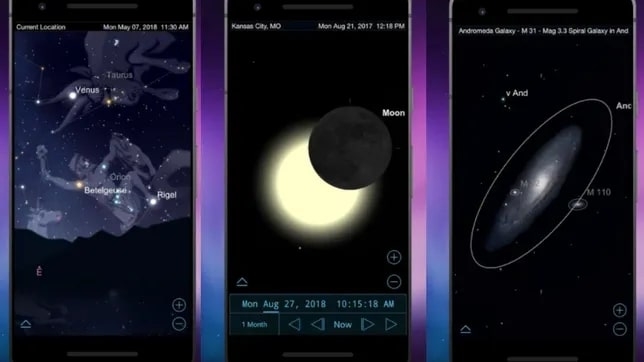 |
| Photo: CNET |
The SkySafari astronomy app, which starts at $5 on iOS and free on Android, lets you hold your phone to the sky to identify planets, constellations, stars and satellites. You can also use the app to see what the sky might've looked like thousands of years ago, or what it will look like in the future.
Simulate past meteor showers, approaching comets and celestial events, like eclipses. SkySafari also has a constellation illustration overlay feature in case you can't quite visualize the lion or bear that everyone else claims to see. The app also offers history, mythology and science information to accompany the images.
If you're not sure where to get started, you can tap Tonight's Best in the app to check out which object in the sky you could get the best look at.
If you haven’t used SkySafari 6 Plus before, here’s a quick list of things you can do with it:
- Hold your device up to find stars, constellations, planets, and more
- Choose between different landscapes
- Work in Alt/Az or Equatorial coordinates
- Simulate the night sky up to 10,000 years in the past or future. Animate meteor showers, conjunctions, eclipses, and other celestial events
- Learn the history, mythology, and science of astronomy. Browse over 1500 object descriptions and astronomical images. Explore NASA space missions. Stay up-to-date with SkyWeek for all major sky events every day
- Simulate the field of view and orientation (equatorial or alt-az) for your different setups
- Control your telescope, log and plan your observations
- Night Vision. Preserve your eyesight after dark
- Orbit Mode. Leave the Earth’s surface behind, and fly through our solar system
- Time Flow. Follow the motion of sky objects as days, months, and years are compressed into a few seconds
- Advanced Search. Find objects using properties other than their name;
- Support for Apple Watch
- Tonight at a Glance: the Sun, Moon, Planets, ISS, and Iridium flares in one handy view
- Notifications when the ISS will pass overhead, when Iridium satellites flare, and more
What Are The Main Features Of SkySafari?
The following are some of the main features of SkySafari 6 Plus:
→ SkySafari 6 Plus will (optionally) back up all of your observing data in secure cloud storage and make it easily accessible to multiple devices as well as from our new web interface, LiveSky.com.
→ Updated star catalog to use the latest and greatest UCAC5 star catalog.
→ Quick access to features like your equipment, observing sites, lists, and observations make it easy and enjoyable to get out, observe, and record your observations.
→ A completely new graph tool offering a quick visual representation of an object’s altitude above the horizon. Essential for planning your night’s observations.
→ An updated planner tool that lets you create a list of targets for your observing session with filters like object types, specific time ranges, constellations, catalog, and more.
→ SkySafari 6 adds basic voice control for a wide range of operations. Say “select Jupiter,” “search for Titan,” “center on Polaris” and SkySafari will do the work for you. Yelling is optional…
Every astronomy app these days lets you tilt and pan your device to show different parts of the sky, SkySafari offers you the ability to control your telescope that way. “Tilt to slew” is an optional mode allowing you to keep your eye in the eyepiece, and using the accelerometers in your device, gently translate the movements of your hands into smooth telescope motion.
SkySafari 6 helps you organize and share your observing experiences. With a free signup, you can see and share your observing data from our web portal, LiveSky.com.
3. Star Tracker
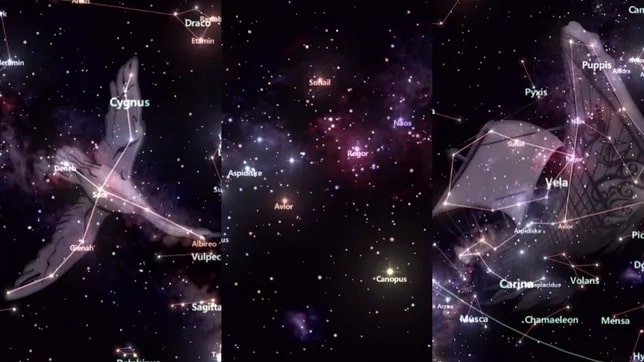 |
| Photo: CNET |
StarTracker Lite - Best StarGazing app to Explore the Universe downloads in a few moments, taking up just 23.8 MB of space on your iPhone or iPad.
Simply fire up this app, give it camera access, and point the device to the night sky. This will give you a detailed look at the night sky, allowing you to find the Sun, Moon, planets of our solar system, and many constellations and stars.
There is also information on the 12 zodiac signs, helping you see the patterns, and six famous deep sky objects with graphics to help you visualize the universe.
This app fully leverages iOS technology, from the camera to the compass. There is a 3D compass graphic integrated into the camera view, which will show you the positioning of the object you're looking at.
The GPS is also integrated into this app, automatically detecting your location, or letting you manually set the location so you can see what the night sky looks like from anywhere on Earth.
This is the "try before you buy" lite version of the app, which gives you a taste of the full version. You can upgrade to the full version for $2.99 once you've made up your mind.
This will give you access to more objects, search functions, and a "time machine" option which lets you go back or forward in time and observe the night sky. A Night Mode "switch" is also included in the full version.
Pros & Cons
Pros
- Point the camera to the night sky and learn about various objects visible in the night sky
- View stunning graphics of the sun, moon, planets, and many famous deep sky objects
- A 3D compass shows you the position of the objects you've searched
- GPS integration allows for automatic location-detecting, while manual location options are also available
- Self-contained app
Cons
- There is nothing negative to say about this app
4. Skyview
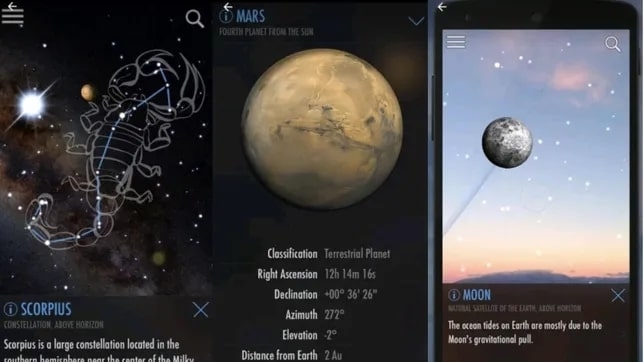 |
| Photo: CNET |
The Skyview app is $3 on iOS and $2 on Android, but both platforms have a free lite version. To use Skyview, just point your device at the sky and you can get started identifying galaxies, stars, constellations, planets -- even the International Space Station. The app has night mode and an AR feature, so you can use it comfortably any time.
The app's Sky Path's feature lets you track objects in space to see exact locations at any date and time. In addition, Skyview has a time travel option to observe what the sky looked like in the past and might look like in the future.
The app is super easy to use and set up. There are a few minor settings that can be tweaked to your taste, such as setting the screen to ‘night-view' and turning off the ambient music, which sounds a little like a lullaby. There is also an option to increase or decrease the star magnitude visibility – magnitude being the brightness of a star – which is very useful if you are in a region of high light pollution.
Two things that do rankle slightly are the need to be pixel-perfect when searching for stars and constellations, as the screen art and information disappears with only a very small movement away from the intended target, and that the AR screen and camera are too dark at night to be used.
Once your device’s onboard compass has worked out where you are and which way you are facing, the app is very accurate. If, however, your device is unable to locate north, then there is a manual option with slide control to manually adjust the screen view. Simply swipe left or right until the stars on your screen match what you can see in the sky.
If you have a ‘real-world’ compass, this can help to locate north or you could use the app to find Polaris (The North Star, contained in Ursa Major and Ursa Minor, if you are in the northern hemisphere), or the southern cross (if you are south of the equator) then align the screen image to the given location. So, in theory, there are multiple ways of making sure the app is aligned correctly.
Like a lot of stargazing apps, the most useful feature on SkyView is its interactive star map. This automatically recognizes objects and constellations, allowing the user to understand which region of the sky they are looking at without the need to refer to bulky star-guides. When an object, planet, or star is within the central region of the screen, its path across the night sky can be clearly seen.
5. Stellarium
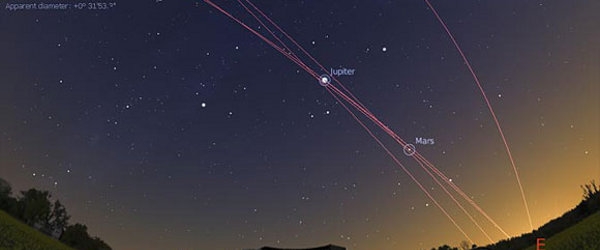 |
| Photo: Stellarium.org |
Stellarium is a free open-source planetarium, showing a realistic sky in 3D from any location and at any time and date.
Stellarium (computer version) has a clean and simple to use interface, with all of the different functions and visualization tools grouped into just 3 menus.
Stellarium is arguably the best tool to plan in advance a photographic session or a visual observation. You can, in fact:
1. Visualize the sky for any date, time, and location you like
2. Take into account atmospheric effects (daylight, sky brightness, etc.)
3. Display the field of view for the setup you intend to use, and you can easily see the effects of combining different gear
4. Search for astronomic events with the astronomical calculator
5. Explore the constellations in different cultures;
6. Control your telescope
7. And more
The Stellarium app is available for Android, iPhone, and iPad. It’s free and open source with an optional one-time “Plus” upgrade for $19.99.
The basic idea of the app is it uses your location to know which constellations will be visible. You can use your finger to pan around or take advantage of your device’s sensors and see the constellations on the screen for exactly where you’re looking.
Stellarium also shows where planets, comets, satellites, and other deep space objects are in real time. You can even zoom in and out to get a different perspective on our planet. It’s a great app to have in your back pocket.
Stellarium MOBILE (free, Android only) has a similar but also some important limitations with respect to the computer version:
1. Can’t easily simulate the field of view of your equipment (you can zoom in/out to the proper FOV in degrees if you know it, though)
2. Can’t show the FOV with the camera/telescope on an equatorial mount
3. Can’t control a telescope
4. Doesn’t feature an astronomical calculator nor a list of upcoming major astronomical events
5. Images of deep-sky objects are not very detailed
6. Information about selected targets are limited to a few physical properties
6. Star Walk 2
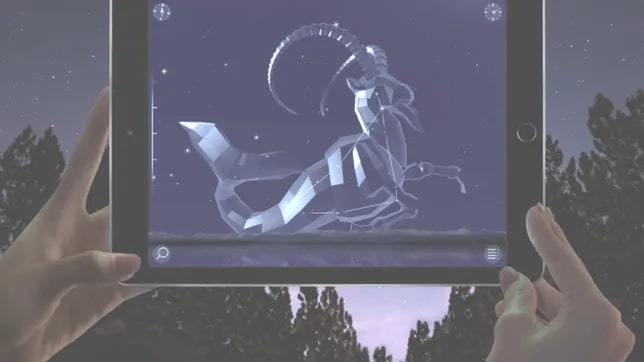 |
| Photo: CNET |
Star Walk 2 is the latest version of the stargazing app from Vito Technology. With a sleek look and easy customizations, the app could be great for both new stargazers and experts looking for a comprehensive stargazing app.
Last updated in January of 2021, the app is the second iteration and works on Android and Apple devices, including iPads. The original version launched in 2001, and the app now has over 10 million downloads.
Star Walk 2 teaches users about stars, constellations, planets and tracks satellites with an augmented reality overlay through your device’s camera. While some stargazing apps can link to your telescope, the Star Walk 2 does not include this feature, and some stargazers may feel the free version is missing elements like extended solar system objects and International Space Station tracking.
Using information from the European Space Agency, Vito Technology says Star Walk 2 includes 200,000 stars, eight planets, 27 asteroids and comets, and 10,000 satellites. It might not be the very best stargazing app(opens in new tab) available, but it does pack a lot in considering its price.
Setting up Star Walk 2 on your smartphone or iPad is straightforward. An introductory swipe-through menu goes over basic instructions to get users accustomed to features and icons on the app’s main screen. Users then set their location or manually enter coordinates to allow the app to reflect the night sky accurately. The menu icon sits in the lower right-hand corner of the screen, where users can customize their desired notifications, as well as indicate how they’d like constellations to appear. Other customizable settings include choosing kilometers or miles and Celsius or Fahrenheit.
The menu also includes a 24-page manual which includes a deep-dive into all the features of Star Walk 2 as well as an FAQ and a glossary section. Users also have the option to go through the initial tour of the app at any time. It's a lot easier to navigate than fleshed out apps like SkySafari 6(opens in new tab), but it doesn't offer quite as much in terms of features.
7. Star Rover
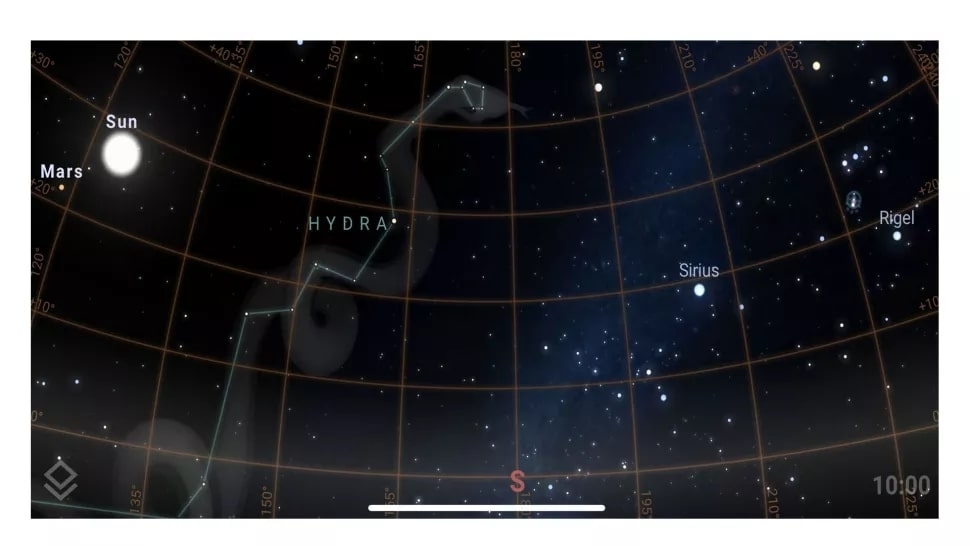 |
| Photo: @Future |
All stargazing applications have one primary function: to teach you about the celestial objects above you in real-time. Star Rover is no different, and is easy to navigate. The app view is configurable, so you can easily navigate through the names of celestial objects as well as equatorial and azimuthal grids. Simply use settings to change the sky view, and Quick Find can tell you what you need to know about the night sky.
There’s also a feature that allows you to travel in time - either forward or backward - to see what the sky would look like at that point in time. Although the interface is user-friendly, there are some options that aren’t clearly explained. We also sometimes found when zooming in on stars, that the text showing their names did not also enlarge, which made them difficult to read.
Two fun aspects of the app are that Star Rover allows you to manually set your location so that you can see what the sky looks like from any point on the globe, and can allow you to travel through time to see what the sky would look like on a specific date and time in the past or future. However, we experienced a few occasional glitches which meant that our location was slightly inaccurate at times, but closing the app and re-opening it often resolved this issue.
The Star Rover stargazing app offers similar features to its major competitors: information on celestial objects, an augmented reality mode, and the ability to change the point in time that you’re observing the sky. After trying to find what distinguishes Star Rover from any other star map app, we realized that there were none, and that it doesn’t quite measure up to its direct competitors’ due to its occasionally lagging user interface and basic features. The font used in the app can also appear slightly blurry and difficult to read, which also makes the app look slightly dated.
 Top 3 Female Zodiac Signs Who Are Often Betrayed in Love Top 3 Female Zodiac Signs Who Are Often Betrayed in Love Find out the 3 Female Zodiac Signs Who Are Often Betrayed in Love For Too Easily Trust and Poor, etc. |
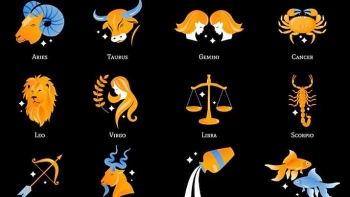 Weekly Horoscope (1 to 7 August, 2022): Astrological Predictions for 12 Zodiac Signs Weekly Horoscope (1 to 7 August, 2022): Astrological Predictions for 12 Zodiac Signs Discover Weekly Horoscopes from August 1 to August 7, 2022 of the 12 zodiac signs Aquarius, Pisces, Aries, Taurus, Scorpio, Capricorn, Leo, Libra, Sagittarius, Gemini ... |
 Best Ways to Remove Evil Spirits in Ghost Month Base on 12 Zodiac Signs Best Ways to Remove Evil Spirits in Ghost Month Base on 12 Zodiac Signs The month of July (lunar calendar) is often full of ghosts according to folk beliefs. Do the 12 zodiac signs know how not to be ... |
 Top 4 Most Superstitious Zodiac Signs, According to Astrology Top 4 Most Superstitious Zodiac Signs, According to Astrology With these superstitious zodiac signs, they are gullible, easily believing in stories about spirituality and the occult. |

